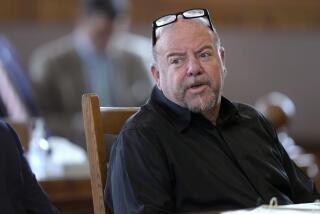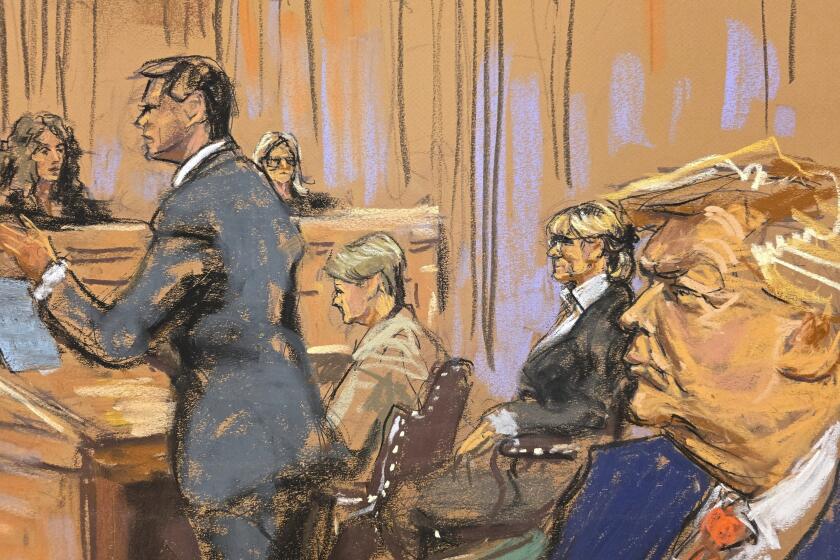Verizon’s hubris
Given the litigious history of the telecommunications industry, it should come as no surprise when a powerhouse phone company sues the Federal Communications Commission over a regulation it doesn’t like. Years of government-guaranteed monopoly profits bred such a sense of entitlement among the telcos that any attempt to open their markets to competition routinely drew fierce responses in court. Nevertheless, the lawsuit filed Sept. 10 by Verizon Wireless set a new standard for hubris. The No. 2 mobile phone company in the country is trying to block regulations that the FCC wants to impose on airwaves that Verizon isn’t even licensed to use, let alone own.
At issue are the rules the FCC recently set for next year’s auction of a prime slice of the UHF TV spectrum. These airwaves -- channels 52 through 69 in the 700 MHz band -- are scheduled to be reclaimed from broadcasters in February 2009, when analog TV signals will be cut off in favor of digital transmission. They are expected to be used for new wireless broadband networks and other advanced services, with a portion reserved for public safety agencies and rescue crews.
Pressed by tech companies (especially Google) and public interest groups, the commission imposed two unusual requirements on roughly one-third of the frequencies at auction: The winning bidder’s wireless network will have to support any compatible device that subscribers want to use on it, and it will have to accommodate any application that doesn’t damage the network. According to Verizon’s lawsuit, the mandate for “open platforms for devices and applications” violates the Constitution, exceeds the FCC’s authority and is “arbitrary, capricious, unsupported by substantial evidence and otherwise contrary to law.”
It’s usually a safe bet to accuse the FCC of acting outside its authority, arbitrarily and/or without a solid foundation of evidence. Still, the commission’s open-access requirements have clear precedents in the wired telephone market, and there’s ample justification for them now on public policy grounds. In fact, the FCC may not have gone far enough in its effort to promote competition in broadband service.
Verizon Wireless -- a joint venture between Verizon and Vodaphone -- wasn’t around in 1956, but Verizon’s forebears (New York Telephone, New England Telephone and GTE) were. That year, the maker of the Hush-a-Phone -- a crude attempt at a noise-cancelling mouthpiece -- won a court ruling that Ma Bell and the FCC couldn’t block attachments to AT&T phones that did not damage the network. Twelve years later, in the Carterfone case, the FCC ruled that AT&T could not bar customers from connecting the devices of their choice to the network. These decisions helped fuel a vibrant and inventive market not just for phones but for answering machines, fax machines, modems -- in fact, anything that used the wired phone network. There has been a fair amount of innovation on wireless phone networks too, but devices in the U.S. have been conspicuously more limited than those in Europe, where manufacturers are less dependent on carriers to make sales.
The notion of opening networks to all forms of data traffic has even deeper roots. For most of their history, wired phone companies have been treated as common carriers. By law, they couldn’t refuse to carry any kind of traffic that was compatible with their networks. That’s one reason so many companies entered the market for dial-up Internet service: they could compete with the phone companies’ services on a level playing field.
The FCC removed this requirement from the phone companies’ high-speed data lines, in part because cable operators aren’t obliged to open their networks to rival Internet providers. Aside from fighting spam and malicious data traffic, however, phone and cable companies have rarely tried to block subscribers from running the applications of their choice through their broadband networks. And when one North Carolina telco did interfere with an application -- a rival’s Internet phone service -- the FCC swatted it down.
That openness has been critical to the Internet’s entrepreneurial spirit and blink-of-an-eye development cycles. In U.S. mobile phone networks, however, the carriers’ control over their phones’ Web interfaces, search functions and applications have held developers to a slower pace.
Foes of the FCC’s new auction rules have said they will lead to lower license fees. With no restrictions on their use, airwaves will go to the bidders who generate the most revenue by delivering the services in greatest demand. That’s the theory, at least.
But there are other factors at work here, ones that don’t align with the public’s interest in increased competition, innovation and value. Verizon Wireless’ desire to protect its existing business, as well as Verizon’s DSL services, give it an incentive to bid more for the spectrum than a new competitor would. That’s even more true for AT&T, which has dominant wireless and DSL services under the same corporate roof. Neither one would have much interest in launching services in the new frequencies that would disrupt its other businesses.
Advocates of open access in the 700 MHz band wanted the FCC to adopt rules that would stop incumbent wireless carriers, such as Verizon Wireless and AT&T, from even bidding. There’s precedent for that too in previous wireless auctions in which the FCC used spectrum caps to ensure room for new entrants.
But this time, the commission focused on promoting freedom and innovation in the airwaves’ use rather than blocking out certain bidders. That’s the right focus, regardless of Verizon Wireless’ legal attack. Trying to replicate the openness of the Internet in a new, mobile broadband network is the right goal. If Verizon Wireless doesn’t want to be in that business, it can watch it from the sidelines.
Jon Healey is a member of The Times’ editorial board and author of the BitPlayer blog; click here to read more of his Opinion Daily columns. Send us your thoughts at opinion@latimes.com.
More to Read
A cure for the common opinion
Get thought-provoking perspectives with our weekly newsletter.
You may occasionally receive promotional content from the Los Angeles Times.











